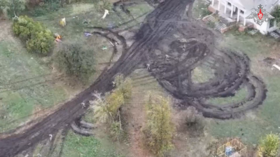Russia gains the upper hand on Central Asian gas
During his trip to the Caucasus, U.S. Vice President Dick Cheney received a cool reception in Azerbaijan. President Ilham Aliev indicated Baku would not support redirecting oil and gas flows to bypass Russia. Russia is making headway in securing Cent
Burdened by its growing dependence on Russia's energy supplies, the European Union was counting on Nabucco. That's a planned pipeline that would bring Azerbaijani, Turkmen and Kazakh gas to Europe.
But the plan looks shaky, after Russia agreed not only to pay European prices for Uzbek gas but also to build a new pipeline that would transport up to 30 billion cubic metres annually from Uzbekistan and Turkmenistan. Victor Mishnyakov, Senior Analyst, at Uralsib believes that with Russia now paying European prices for gas, there is little motivation for central Asian producers to look at other conduits to European markets.
“When Russia is willing to pay a proper price for the Turkmenistan or Uzbekistan gas, as well as Azerbaijani gas, obviously all of these three countries would be equally willing to sell oil to Russia, to be pumped over to the western or eastern European countries via Russian territories, rather than use other territories to supply the gas to the same very markets.”
Russia's Gazprom has a rival project that targets the same markets as Nabucco. South Stream would run from Russia's Black Sea coast to Bulgaria, avoiding Georgia as a transit route. Lev Snykov, Analyst at VTB Capital, says that's a major advantage.
“The gas which this pipeline should be filled with, is running through the Baku –Tbilisi –Erzurum pipeline, therefore indirectly Nabucco is exposed to Georgian risk. Consequently, with the current situation, Europe would be thinking whether it makes sense to stick to Gazprom’s South Stream project, or still go ahead with Nabucco and running the Georgian risk.”
There are also doubts about Europe's political will to pursue the Nabucco project – with some EU members keen to avoid compromising current supply contracts with Russia. But Snykov says its still possible the two pipelines can profitably co-exist.
“If Europe does need really more gas and if Central Asia can supply more gas then I think Gazprom can go ahead with the South Stream project and at the same time the Nabucco consortium, which is dominated by Germany Austria and Hungary can go ahead with the Nabucco project and they can exist together.”
While the future of the Nabucco pipeline is still uncertain, one thing is clear: Russia has already struck supply agreements with major producing countries in the region. And that could mean western companies – and politicians – looking for deals in Central Asia are late to the game.












